Our image processing algorithm looks for two landmarks in the camera image: the pupil center and the reflection of the the infrared lamp on the cornea (also known as the first Purkinje image). The pupil is non-reflective and appears very dark in infrared; the corneal reflection is a bright spot in the image.
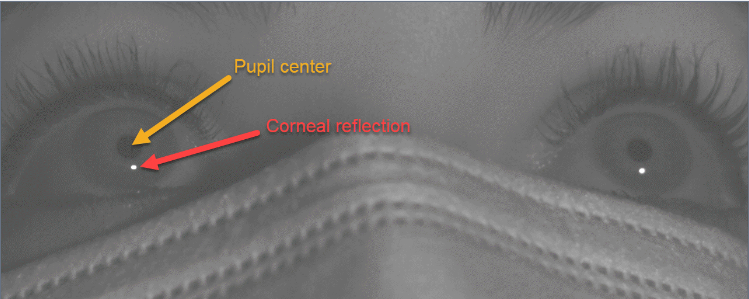
As we look around a surface, the vector between these two locations changes systematically:

The purpose of the eye-tracking Calibration Procedure is to build a model of this systematic change as the participant looks around the display. Once this model is established, it can be applied to estimate the point of gaze in real-time during an experiment.
Generally speaking, issues with poor calibration, tracking loss and poor quality gaze data can often be traced back to issues detecting the pupil center and corneal reflection during or after calibration. Resolving these issues can lead to improved data quality.
This guide contains a list of some common issues experienced during eye tracking. Examples and descriptions are provided, along with tips for how to solve these issues. This list is ordered from most common to least common, based on the experience of VPixx Staff Scientists.
Smearing or absence of the corneal reflection
Description: The corneal reflection is not a point; rather, it is elongated, broken or entirely absent from one or both eyes.
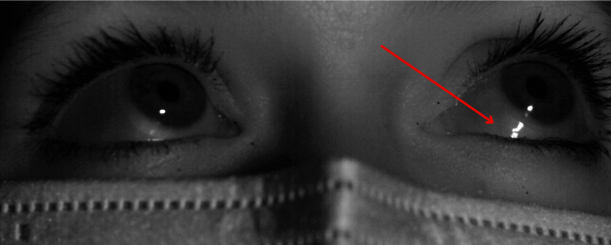
Cause: The angle of the infrared lamp and the participant’s cornea is too steep. May be due to bad tracker positioning and/or overly eccentric gaze positions.
Recommendations:
-
Position the camera and lamp as close as possible to the bottom of the display, as level as possible.
-
Do not use eccentric gaze positions >35 degrees of visual angle. These are outside the trackable range for infrared video-based eye trackers and are almost guaranteed to disrupt the corneal reflection.
-
Calibrate only the portion of the screen you are using in your experiment.
Glare
Description: Additional bright spots in the image around the eyes.
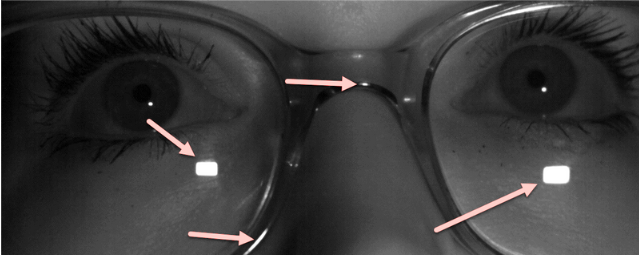
Cause: The infrared light is reflecting off additional reflective surfaces in the image. Usually caused by glasses, hard contact lenses, jewelry or sparkly makeup.
Recommendation:
-
Remove the reflective surface if possible. Ask participants to remove their makeup or jewelry.
-
Cover reflective surfaces (e.g., with matte athletic tape, for jewelry).
-
Use search windows in the calibration procedure to restrict the area in the image where the tracking algorithm searches for landmarks.
Individual differences (eye colour, large pupils, cataracts, hooded eyes)
Description: A small percentage of participants are not tracking well.
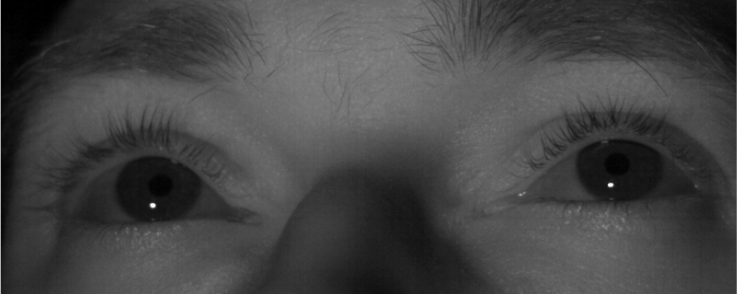
Cause: Some individuals have very light irises, which reflect little infrared light and can make it more difficult to detect the pupil center and width. Very large pupils are also difficult to track. Finally, conditions that make the eyes reflective (cataracts) or characteristics which prevent the pupil being fully visible (monolids, half-closed eyes) can also create poorer tracking.
Recommendations:
-
Consider relaxing the threshold for an acceptable calibration for these individuals, or removing their data from the study altogether
-
In some cases, you may be able to track a single eye well. Switch to monocular tracking in this case
Small depth of field
Description: One eye is in focus and tracks well, while the other eye is blurry/tracks poorly.

Cause: The participant’s eyes are not completely aligned in depth, and the depth of field of the camera cannot focus both at the same time.
Recommendations:
-
If the participant’s head is noticeably tilted, ask them to reposition.
-
Reduce the aperture of the camera (anterior ring on the lens) to reduce the amount of light passing into the camera. This will increase the depth of field and should allow you to focus both eyes. Don’t worry if the tracking window image is dark; the tracker does not need much light to operate.
Drift
Description: Tracking quality is degrading over time.

Cause: Usually due to subtle shifts in the participant’s position in the chinrest over time (e.g., slouching). Calibration loses some effectiveness. More common in longer studies.
Recommendations:
-
Incorporate drift checks into your experiment at intervals to asses tracking quality
-
Some drift is inevitable. Only recalibrate the tracker if the drift reaches unacceptable levels, as poor recalibration can also risk producing inferior results.
Other reflections
Description: Additional reflective spots or areas in the eyes, typically around the edges of the sclera or the lower eyelid.
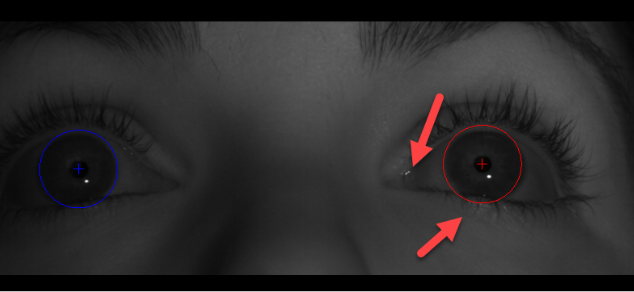
Cause: Other sources of infrared light are reflecting off the eyes. Distinct from glare, which is caused by the infrared lamp. Sunlight, and some overhead lighting, contain infrared light.
Recommendations:
-
Remove other light sources. Cover windows and turn off overhead lighting, where necessary.
Blinking during calibration or validation
Description: Calibration appears poor for a specific target, for both eyes. The participant may or may not have reported that they blinked.
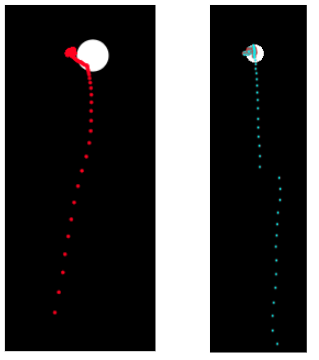
Cause: Participant blinked.
Recommendations:
-
Blinks are obvious in visualized data; they are rapid, vertical saccades in both eyes.
-
If a blink happens during calibration, you will need to recalibrate.
-
If a blink happens during validation, consider a subset of the tracking data before/after the blink occurs. For example, in the left image above, the fixation before the blink (the cluster of red) is quite close to the target. You can safely accept a validation with data like this, even if the average error reported is quite large.
Shadows over one eye (MRI installations)
Description: A shadow over one eye in MRI tracking specifically.
Cause: The MR headcoil is blocking the infrared light to part of the face.
Recommendations:
-
Switch to monocular tracking of the eye that is not shadowed.
Half-closed eyes (MEG installations)
Description: Participant’s eyes are half-closed.
Cause: Most common in MEG settings where the participant is reclined and looking downward at a screen. This can prompt the eyelid to lower, covering some of the eye and impairing tracking. May be more common in older participants.
Recommendations:
-
Ask the participant to try and keep their eyes fully open in the task
-
Consider raising the screen
Reflective pupils (infants, non-human primates)
Description: Unable to track the pupils of special populations (some infants, non-human primates)
Cause: The pupils of these populations can reflect some IR light, and may not be dark enough to be detected as a pupil.
Recommendations:
-
Use a different illuminator. We offer a 940 nm lamp which is more effective with these populations.
-
Adjust the pupil black level threshold. This setting is currently only available in the LabMaestro software. Raising this threshold will prompt the camera to accept lighter areas in the image as a potential pupil, and can improve tracking stability.